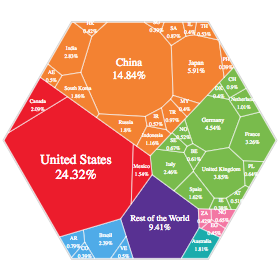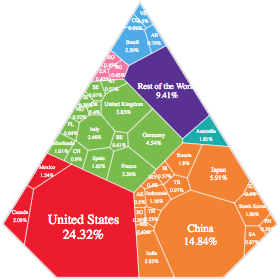This D3 plugin produces a Voronoï treemap. Given a convex polygon and nested weighted data, it tesselates/partitions the polygon in several inner cells which represent the hierarchical structure of your data, such that the area of a cell represents the weight of the underlying datum.
Because a picture is worth a thousand words:
Available only for d3 v4 and d3 v5.
If you're interested on one-level map, take a look at the d3-voronoi-map plugin, which may be simpler to use (no need of a d3-hierarchy).
D3 already provides a d3-treemap module which produces a rectangular treemap. Such treemaps could be distorted to fit shapes that are not rectangles (cf. Distorded Treemap - d3-shaped treemap).
This plugin allows to compute a treemap with a unique look-and-feel, where inner areas are not strictly aligned each others, and where the outer shape can be any hole-free convex polygons (squares, rectangles, pentagon, hexagon, ... any regular convex polygon, and also any non regular hole-free convex polygon).
The drawback is that the computation of a Voronoï treemap is based on a iteration/looping process. Hence, it requires some times, depending on the number and type of data/weights, the desired representativeness of cell areas.
- The Global Economy by GDP, a remake of HowMuch.net's article
If you use NPM, npm install d3-voronoi-treemap. Otherwise, load https://rawgit.com/Kcnarf/d3-voronoi-treemap/master/build/d3-voronoi-treemap.js (or its d3-voronoi-treemap.min.js version) to make it available in AMD, CommonJS, or vanilla environments. In vanilla, you must load the d3-weighted-voronoi and d3-voronoi-map plugins prioir to this one, and a d3 global is exported:
<script src="https://d3js.org/d3.v4.min.js"></script>
<script src="https://raw.githack.com/Kcnarf/d3-weighted-voronoi/master/build/d3-weighted-voronoi.js"></script>
<script src="https://raw.githack.com/Kcnarf/d3-voronoi-map/master/build/d3-voronoi-map.js"></script>
<script src="https://raw.githack.com/Kcnarf/d3-voronoi-treemap/master/build/d3-voronoi-treemap.js"></script>
<script>
var voronoiTreemap = d3.voronoiTreemap();
</script>In your javascript, in order to define the tessellation:
var rootNode = d3.hierarchy(nestedData); // a d3-hierarchy of your nested data
rootNode.sum(function(d) {
return weightAccessor(d);
}); // assigns the adequate weight to each node of the d3-hierarchy
var voronoiTreemap = d3.voronoiTreemap().clip([[0, 0], [0, height], [width, height], [width, 0]]); // sets the clipping polygon
voronoiTreemap(rootNode); // computes the weighted Voronoi tessellation of the d3-hierarchy; assigns a 'polygon' property to each node of the hierarchyThen, later in your javascript, in order to draw cells:
var allNodes = rootNode.descendants;
d3
.selectAll('path')
.data(allNodes)
.enter()
.append('path')
.attr('d', function(d) {
return cellLiner(d.polygon) + 'z';
})
.style('fill', function(d) {
return fillScale(d.data);
}); // d is a node, d.data is your original data- based on Computing Voronoï Treemaps - Faster, Simpler, and Resolution-independent
- https://github.com/ArlindNocaj/power-voronoi-diagram for a Java implementation
# d3.voronoiTreemap()
Creates a new voronoiTreemap with the default clip, convergenceRatio, maxIterationCount and minWeightRatio configuration values.
# voronoiTreemap(root)
Computes the Voronoï treemap for the specified d3-hierarchy, where root is the root node of the hierarchy, assigning a polygon property on the root and its descendants. A polygon is represented as an array of points [x, y] where x and y are the point coordinates, a site field that refers to its site (ie. with x, y and weight retrieved from the original data), and a site.originalObject field that refers to the corresponding element in data. Polygons are open: they do not contain a closing point that duplicates the first point; a triangle, for example, is an array of three points. Polygons are also counterclockwise (assuming the origin ⟨0,0⟩ is in the top-left corner).
As others d3-hierarchy layouts (rectangular treemap, or circle packing), the Voronoï treemap layout considers the weight of a node to be the value propertyof that node. Hence, you must call root.sum before passing the hierarchy to the Voronoï treemap layout, in order to properly set the value property of each node (root, intermediates and leaves). For example, considering that your original nested data have leaves with a weight property, you must use rootNode.sum(function(d){ return d.weight; }).
# voronoiTreemap.clip([clip])
If clip is specified, sets the clipping polygon. clip defines a hole-free convex polygon, and is specified as an array of 2D points [x, y], which must be (i) open (no duplication of the first D2 point) and (ii) counterclockwise (assuming the origin ⟨0,0⟩ is in the top-left corner). If clip is not specified, returns the current clipping polygon, which defaults to:
[[0, 0], [0, 1], [1, 1], [1, 0]];# voronoiTreemap.convergenceRatio([convergenceRatio])
If convergenceRatio is specified, sets the convergence ratio, which stops computation when (cell area errors / (clip-ping polygon area) <= convergenceRatio. If convergenceRatio is not specified, returns the current convergenceRatio , which defaults to:
var convergenceRation = 0.01; // stops computation when cell area error <= 1% clipping polygon's areaThe smaller the convergenceRatio, the more representative is the treemap, the longer the computation takes time.
# voronoiTreemap.maxIterationCount([maxIterationCount])
If maxIterationCount is specified, sets the maximum allowed number of iterations, which stops computation when it is reached, even if the convergenceRatio is not reached. If maxIterationCount is not specified, returns the current maxIterationCount , which defaults to:
var maxIterationCount = 50;If you want to wait until computation stops only when the convergenceRatio is reached, just set the maxIterationCount to a large amount. Be warned that computation may take a huge amount of time, due to flickering behaviours in later iterations.
# voronoiTreemap.minWeightRatio([minWeightRatio])
If minWeightRatio is specified, sets the minimum weight ratio, which allows to compute the minimum allowed weight (= maxWeight * minWeightRatio). If minWeightRatio is not specified, returns the current minWeightRatio , which defaults to:
var minWeightRatio = 0.01; // 1% of maxWeightminWeightRatio allows to mitigate flickerring behaviour (caused by too small weights), and enhances user interaction by not computing near-empty cells.
- d3-voronoi-map.voronoiMap
In order to test the code
git clone https://github.com/Kcnarf/d3-voronoi-treemap.git
[...]
yarn install
[...]
yarn test


